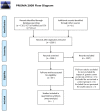Prenatal, Perinatal and Neonatal Risk Factors for Intellectual Disability: A Systemic Review and Meta-Analysis
- PMID: 27110944
- PMCID: PMC4844149
- DOI: 10.1371/journal.pone.0153655
Prenatal, Perinatal and Neonatal Risk Factors for Intellectual Disability: A Systemic Review and Meta-Analysis
Abstract
Background: The etiology of non-genetic intellectual disability (ID) is not fully known, and we aimed to identify the prenatal, perinatal and neonatal risk factors for ID.
Method: PubMed and Embase databases were searched for studies that examined the association between pre-, peri- and neonatal factors and ID risk (keywords "intellectual disability" or "mental retardation" or "ID" or "MR" in combination with "prenatal" or "pregnancy" or "obstetric" or "perinatal" or "neonatal". The last search was updated on September 15, 2015. Summary effect estimates (pooled odds ratios) were calculated for each risk factor using random effects models, with tests for heterogeneity and publication bias.
Results: Seventeen studies with 55,344 patients and 5,723,749 control individuals were eligible for inclusion in our analysis, and 16 potential risk factors were analyzed. Ten prenatal factors (advanced maternal age, maternal black race, low maternal education, third or more parity, maternal alcohol use, maternal tobacco use, maternal diabetes, maternal hypertension, maternal epilepsy and maternal asthma), one perinatal factor (preterm birth) and two neonatal factors (male sex and low birth weight) were significantly associated with increased risk of ID.
Conclusion: This systemic review and meta-analysis provides a comprehensive evidence-based assessment of the risk factors for ID. Future studies are encouraged to focus on perinatal and neonatal risk factors and the combined effects of multiple factors.
Conflict of interest statement
Figures
References
-
- American Psychiatric Association (1994) Diagnostic and statistical manual of mental disorders: DSM-IV Washington, DC.
-
- Curry CJ, Stevenson RE, Aughton D, Byrne J, Carey JC, Cassidy S, et al. Evaluation of mental retardation: recommendations of a Consensus Conference: American College of Medical Genetics. American journal of medical genetics. 1997;72(4):468–77. - PubMed
-
- Rauch A, Hoyer J, Guth S, Zweier C, Kraus C, Becker C, et al. Diagnostic yield of various genetic approaches in patients with unexplained developmental delay or mental retardation. Am J Med Genet A. 2006;140A(19):2063–74. - PubMed
Publication types
MeSH terms
LinkOut - more resources
Full Text Sources
Other Literature Sources




